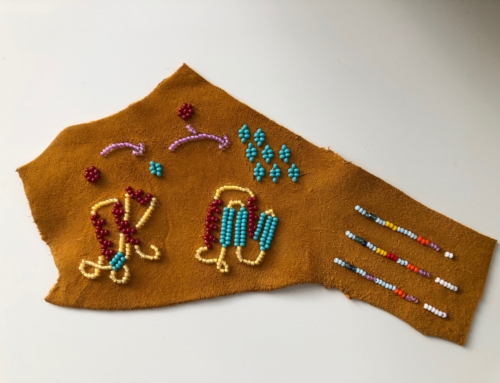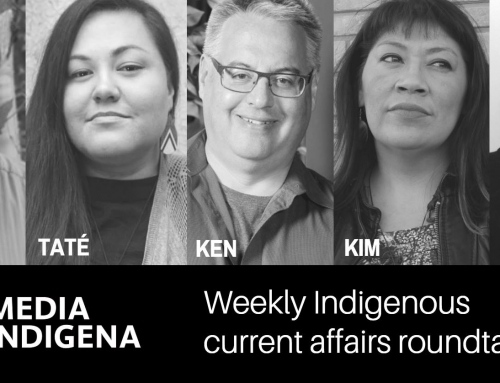Cross-posted from www.oaklakewriters.org, an organization of Oceti Sakowin writers in which I am a member, and on whose behalf I also blog.

On the third day of the Oak Lake Writers Society (OLWS) annual retreat, August 1, 2012, University of Illinois Associate Professor of American Indian Studies, Jodi Byrd (Chickasaw) led a fascinating session by this name. We got down to analytical business pretty quickly and discussed how the zombie/demon/monster narrative, along with Christianity, is a founding myth of the United States. Our tribal writers, most of whom work with more traditional genres (and I don’t necessarily mean “traditional” in the tribal sense here), nonetheless were very lively participants in Jodi’s session.
She explained the links between such narratives, both in film and in (video) gaming and how Indians get designated as monsters. Alternately Indians get erased and the landscape gets represented as empty in many such works. These are ways in which they resonate with more traditional forms, including captivity narratives and westerns, for example. She noted that a surprising number of video games have Indian motifs of both violence and erasure. She cited a game called Prey that features the “agnosia” she spoke of yesterday—a term she borrows from neurological science, a form of blindness in which one’s eyes can see but one cannot comprehend what one sees. In this game a Cherokee named Domasi “Tommy” Tawodi traverses a treacherous landscape to defend the land from invaders from space, aliens. As Jodi points out, “the use of ‘prey’ is a double entendre of savage Indians on the one hand, and the fact that the invading aliens have upended the food chain and surpassed humans at the top.” Jodi argues that it is incomprehensible that the character Tommy could be defending the land from invaders from Europe, from colonialists. I asked what demographic creates games. Jodi responded that the majority of game developers are white and Asian males. Again, agnosia: Colonial violence and history—even what one sees before one’s eyes—cannot be comprehended. Overall, I think our writers found this a useful analytical intervention. Gabrielle Tateyuskanskan noted a slightly different—perhaps related problem. In mainstream classrooms Indian students “analyze in silence” the dominant narratives we’re fed, for example, of Indians as consorting with faeries (i.e. in Peter Pan) and therefore as not real, or Indians as absent from a landscape in which historically there was tremendous encounter and violence (e.g. Little House on the Prairie).
A lively discussion ensued around Jodi’s intellectual challenge in this area: If popular genre—science fiction, fantasy, and horror—are part of how settler colonialism processes its history and its role in this place, what then are the implications for us as Native writers taking up this genre? And what are the implications for how we take this up? Jodi asks, “Are we stuck with realism [and I presume she meant, the decolonial work we do here in the material realm], or can we also decolonize imagination?” We’re really skilled in American Indian Studies (AIS), she notes, at talking about the western and its role in the colonial narrative, but now we have all of these newer forms that now have more popular influence than that form. And Native writers are taking them up. She argues that all vampire and zombie stories are essentially captivity stories—that essentially the captive gets infected or contaminated and transformed. She also notes that the zombie narrative when it emerged with George Romero in the late 1960s was—lit critics have argued—a critique of whiteness. The zombies, pale and (un)dead, represented the advancing infection of whiteness. But she argues that the zombie narrative has flipped to where whiteness takes control of it in the 21st century. The zombie becomes invader, terrorist, the infectious agent that must be controlled, contained, and wiped out. The zombie’s subjectivity has flipped since its first emergence in the popular U.S. American imagination from a critique of whiteness to now being subjected to the nationalist authority of whiteness. I am no longer slightly embarrassed that I love zombie films. There is apparently so much in them for an intellectual to love.
Our regular co-mentor Elizabeth Cook-Lynn seemed less convinced, or perhaps she was just playing devil’s advocate when she asked “Why is it that Native writers are taking all of this up? And what are the implications?” Jodi added, that we should think about whether taking up these new forms is “a mark of assimilation, or does it help decolonize the imagination?” My fellow Oak Lakers are much more erudite fiction readers than I am. I read mostly academic writing and hardly ever fiction. Yet it seems to me that taking up science fiction, fantasy, and horror, given their pervasive influence in popular culture, is not fundamentally different from how our forebears first took up the novel, the short story, and the poem, or from how my fellow indigenous academics and I take up academic forms of writing. Jodi cited a Canadian Anishinaabeg writer, Drew Hayden Taylor, who entangles in a young adult gothic novel form the vampire story with a story of European/indigenous contact and the Anishinaabeg Windigo story. She argues that to take up this genre is to take control of it in a way that centers indigenous experience and knowledges.



